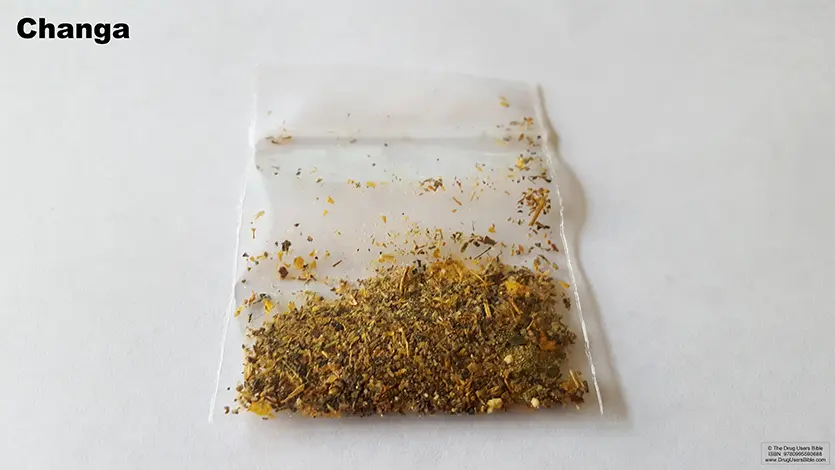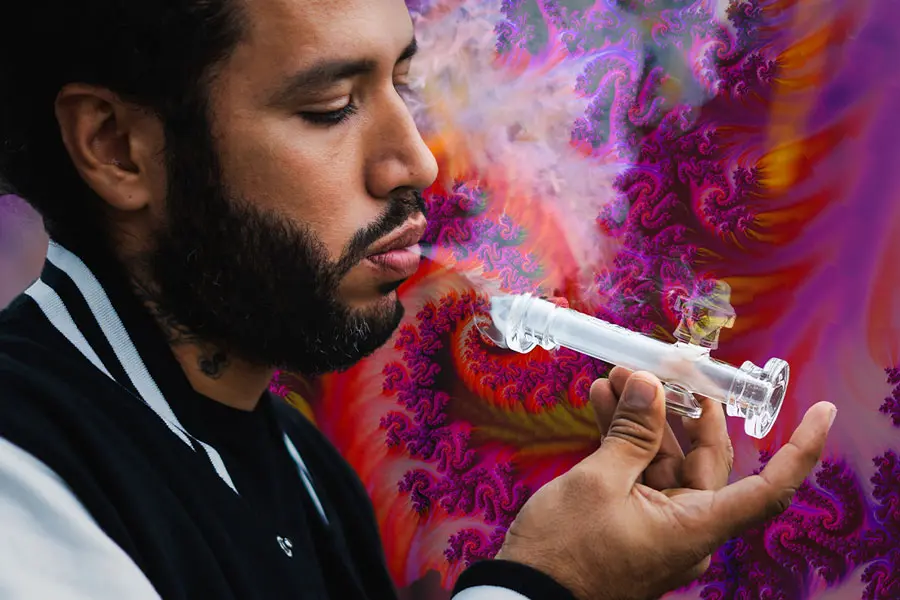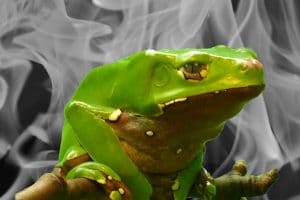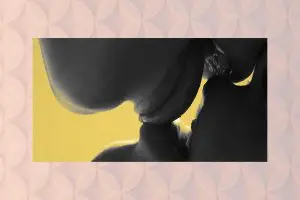In many ways, exploring psychedelics involves opening your mind to the one thing that human beings fear most: death. And while it may sound more than a tad dramatic, this statement is actually true—researchers are investigating similarities between psychedelic experiences and near-death experiences. The psychedelic of choice for these experiments? N-n-dimethyltryptamine (DMT), the main hallucinogen in ayahuasca and changa.
Ayahuasca and changa are both botanical preparations of DMT (although, the two have very different origins). Ayahuasca is both the common name of the Banisteriopsis caapi vine and the psychoactive drink traditionally prepared by some Amazonian tribes. It has a history of use that dates back at least 1,000 years.
Changa isn’t so traditional. The herbal blend was popularized in the early 2000s by an Australian man named Julian Palmer. To make changa, Palmer spiked dried caapi vine with isolated DMT and rolled it into a smokable joint. Yet, while Palmer is the man behind the name “changa”, he certainly wasn’t the first person to mix DMT with smokable herbs. Before Palmer, parsley and other plants were commonly used for this purpose.
What is Changa (a.k.a Changa DMT)?
Simply stated, changa refers to a blend of smokable herbs spiked with DMT. However, there is plenty of debate within the psychedelic community over what constitutes “true” changa. According to Palmer, true changa contains the ayahuasca vine. “Without ayahuasca in the changa,” he writes, “the ayahuasca will not truly activate the other herbs, the duration will not be the same, and the same smoothness will not be there.”
Other common changa herbs include Mimosa hostilis (jurema preta) and Peganum harmala (Syrian rue). But, changa sold illicitly can include mixes of just about anything. Sometimes the herbal mixture might consist of Banisteriopsis caapi, sometimes Syrian rue, sometimes parsley, or sometimes it might be something else entirely.
Changa: Risks
Let’s face it—unless you have an excellent source, buying changa can be risky. Various kinds of chemically treated “herbal mixes” are available in the illicit market. In some cases, consuming an unknown herbal mix can be likely very harmful—just look to the example of synthetic cannabis.
How to Grow Shrooms Bundle
Take Both of Our Courses and Save $90!
Synthetic marijuana, often sold under names like spice and K2, looks a lot like changa. Unfortunately, these herbal blends can be treated with seemingly any sort of chemical compounds and then sold to unwitting consumers. The result can be dangerous; synthetic cannabis lands more people in the hospital than actual cannabis (marijuana itself has never caused any deaths). Synthetic weed, however, is far more fatal than the real deal—in 2018, contaminated synthetic cannabis caused multiple cases of fatal internal bleeding in Illinois.
Changa and synthetic cannabis are two very different things. However, the two herbal mixes have an important thing in common. To the untrained eye, they both look like baggies filled with dried potpourri. Given that changa is still an illicit substance, it’s the consumer that faces the burden of researching and ensuring the validity of what they’re buying.
What Does Smoking Changa Do?
DMT is dubbed “the spirit molecule” for a reason. It’s an entheogen. An entheogen is a plant or synthetic drug that can inspire feelings of intense spirituality. In traditional ceremonies, ayahuasca is used as a conduit to the spirit world. Although, how that spirit world manifests to you and how you understand it is likely influenced by culture and language.
In Western scientific terms, DMT may induce bodily processes that mimic those that occur during near-death experiences. In 2018, in fact, researchers at the Imperial College London decided to put DMT to the test. In a study, they compared the experiences described by patients given intravenous DMT with those commonly reported by people who have had a traumatic near-death experience.
Read: Rick Strassman on DMT and the Mystical State
Both DMT and near-death experiences can cause feelings of leaving the body. During these experiences, people report being aware of their death. Strong sensations of calmness and peace often accompany this awareness. Images of spirit beings are also common, although the forms these entities take may be unique to the individual. During a DMT experience, it’s not uncommon for participants to undergo ego death, a temporary process by which you transcend your mundane sense of self. “Ego death is like being awake and having no sense of personal identity,” study researcher Robin Carhart-Harris tells BBC. And while the experience may seem frightening to some, the ego may be replaced by feelings of oneness and connection with others and your surroundings. This type of connectedness may be a hallmark of spiritual experiences.
However, researchers are still trying to piece together precisely what DMT does to the human body, and why exactly it occasions these entheogenic experiences. The bottom line? The DMT in changa will likely make you hallucinate. But, the meaning and significance of that experience are for you to decide.
How is Changa Made?

Making changa requires some basic knowledge of herbalism. Two biochemical elements make changa effective: DMT and an enzyme inhibitor called an MAOI (monoamine oxidase inhibitor). Changa is made using herbs that work synergistically with DMT. In it’s smoked form, pure DMT does trigger a hallucinogenic experience. But it doesn’t last long. DMT is quickly broken down in the human body by MAO enzymes. This enzyme is usually responsible for breaking down neurotransmitters like serotonin and dopamine.
An MAO inhibitor can be a synthetic or naturally occurring chemical compound that blocks the activity of the MAO enzyme. Thus, it prevents the rapid breakdown of DMT and allows more DMT to interact with your system. So, to make changa, herbalists carefully choose plants that naturally contain DMT and botanical MAO inhibitors. The ayahuasca vine naturally contains MAO inhibitors, as does Syrian rue. (Note that when the ayahuasca vine is combined with the DMT-containing chacruna plant, the vine elongates the DMT experience.)
Once herbalists select their base plants, it’s time to infuse them with extracted DMT. Good herbalists will use naturally sourced DMT that has been extracted from plants (such as chacruna, with which ayahuasca is made) using a solvent. Then, herbalists infuse this isolated DMT among new herbs by mixing the hallucinogen and the dried herbs in alcohol. The alcohol is left to evaporate, leaving behind only dried herbs laced with DMT.
And there you have it—changa is a blend of carefully selected herbs laced with DMT.
Changa vs. DMT vs. Ayahuasca
Changa may contain the ayahuasca vine, but the changa experience is a far cry from that of traditionally prepared ayahuasca. The most significant difference between the two is how they are consumed. You smoke changa, but you drink ceremonial ayahuasca. When you smoke changa, the resulting psychoactive experience lasts for 10 to 15 minutes with up to 40 minutes of “afterglow.”
In contrast, the traditional ayahuasca experience can last between two and six hours, depending on the dose. In some ways, changa is like a meaningful hike, whereas ayahuasca is a pilgrimage. Both of these forms are different from freebasing DMT, which lasts a mere 10 to 20 minutes—a short trip around the hallucinogenic block.
Read: Ayahuasca Benefits: The Health and Healing Powers of This Plant Medicine
The human body processes each of these three consumption methods differently. The active compounds in the ayahuasca plants take the longest to leave your system when ingested orally. Changa offers the second-longest experience due to its herbal blend; while it often contains the same plants as traditional ayahuasca, they’re not ingested orally. Instead, the active compounds make their way into the bloodstream through the lungs, which gives them faster access to the brain.
Finally, freebase DMT contains DMT only. That means that there are no synergistic MAO inhibitors that would otherwise amplify the effects of the hallucinogen. As such, freebasing DMT provides the shortest possible experience. However, the afterglow can also last upwards of 40 minutes.
Changa: DMT Experience
As with any psychedelic, everyone’s experience on changa is different—and will also be different each time they do it. Visuals are common on changa: colors, patterns, and distortion of light. Many also report that changa makes them feel more aware of their body—aches and pains that they’ve been feeling, but perhaps haven’t been paying attention to; an awareness of the temperature of their body; or the blood moving through their veins. Many also report that they feel “the spirit of the ayahuasca vine” or “grandmother ayahuasca” while on changa, and that it can be a helpful way to reconnect with that spirit, for the purposes of integration, without committing to a full night’s journey.
Is Changa Legal?

In the United States, the plants used to make changa are legal. However, DMT is not. The hallucinogen is classified as a Schedule 1 substance under the Controlled Substances Act, and it is considered to have no medical value. Certainly, many researchers who work in the psychedelic sciences disagree with the compound’s current scheduling status. But, all complaints aside, the DMT used to make changa is illegal.
In Canada, both Banisteriopsis caapi and Peganum harmala are controlled substances. Similarly, in Australia, both DMT and alkaloids from the harmala plant are controlled. DMT is also illegal in most of Europe and Israel.
How to Grow Shrooms Bundle
Take Both of Our Courses and Save $90!
So, changa is de facto illegal in many places around the world.
How to Smoke Changa: How Much Changa Should You Consume?
As with any mind-altering substance, the adage “start low, go slow” applies to changa. The biggest risk factor with changa is not knowing what you’re buying. Without protection from the law, the likelihood of being sold a contaminated or downright fake product are high. So, it’s of vital importance to test any changa you consume with a testing kit ahead of time. It’s also important to start with just a small amount of changa to hedge against potential bad reactions.
If made using the Julian Palmer method, changa contains roughly 25 percent DMT. That means there are roughly 250 milligrams of DMT per gram of dried herbs. Palmer suggests that this “equates to 30 light experiences, 20 pretty decent experiences, ten much stronger experiences, and five very strong experiences.” So, stay safe by starting small. In the worst-case scenario, medical professionals are concerned that psychedelics like DMT may exaggerate mental health issues. Additionally, they may cause severe adverse reactions when used in an uncontrolled way, especially if the material is contaminated.
Interested in having a psychedelic experience, but don't know where to start? Get our definitive guide on trusted legal retreat centers, clinical trials, therapists, and more.



